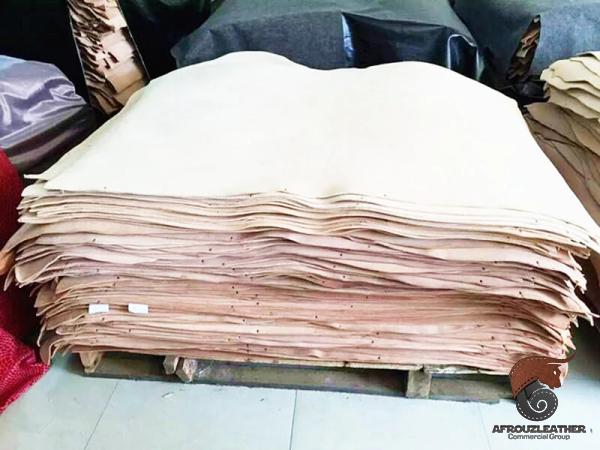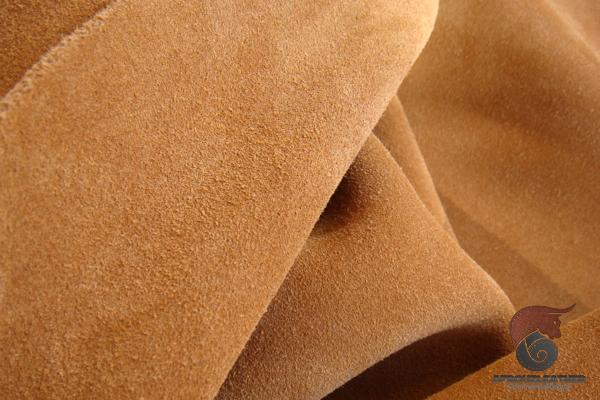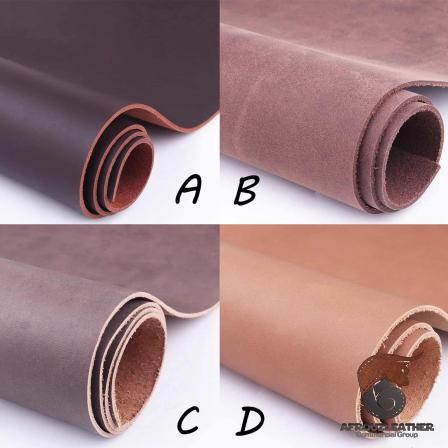Leather is a versatile and durable material that has been used for centuries in numerous industries, including fashion, automotive, and furniture. When it comes to leather, there are two primary types: finished and unfinished. Each type has its own unique characteristics, advantages, and applications. Finished leather, as the name suggests, undergoes a series of treatments and processes to enhance its appearance, texture, and durability. These treatments include applying pigments, dyes, and protective coatings to the surface of the leather. The use of these finishes provides several benefits, such as enhancing stain resistance, color vibrancy, and overall protection from wear and tear. Additionally, finished leather often has a consistent appearance and texture, making it more appealing to consumers who prefer a polished and uniform look. This type of leather is commonly used in the production of high-end fashion accessories, upholstery, and automotive interiors. On the other hand, unfinished leather, also known as raw or natural leather, is the purest form of leather available. It undergoes minimal processing and retains its natural characteristics, such as grain patterns, scars, and blemishes. Unfinished leather is prized for its authentic and rustic appeal, as it showcases the true beauty of the animal hide. It also tends to be softer and more breathable than finished leather, making it more comfortable to wear as clothing or use as upholstery. Unfinished leather is commonly used in the production of handmade leather goods, such as bags, belts, and wallets, as well as in furniture upholstery, where a more natural and aged look is desired. When comparing the two types of leather, there are several factors to consider. The first is cost. Finished leather tends to be more expensive than unfinished leather due to the additional processing and treatments involved. The added cost is reflective of the enhanced aesthetics, durability, and overall quality that finished leather offers. However, for those on a tighter budget or looking for a more authentic and natural look, unfinished leather may be the more affordable option. Another important factor to consider is maintenance. Finished leather usually requires less maintenance and care, as the protective coatings and finishes help repel stains and provide a level of water resistance. It can be easily cleaned with a damp cloth and leather conditioner, making it more suitable for high-traffic areas or products that are exposed to frequent use. Unfinished leather, however, requires more attention and care, as it is more susceptible to stains and water damage. Proper cleaning and conditioning routines are necessary to maintain the integrity and appearance of unfinished leather products. Durability is also a significant consideration when choosing between finished and unfinished leather. Finished leather, with its protective coatings and finishes, tends to be more resistant to scratches, fading, and general wear and tear.
leather
 This makes it a popular choice for items that need to withstand heavy use, such as handbags, shoes, and car seats. Unfinished leather, while it may develop a patina over time, is generally less resistant to damage and may show signs of wear more quickly. However, some individuals prefer the natural aging process of unfinished leather, as it adds character and uniqueness to the product. Finally, it is essential to consider personal preference and intended use when choosing between finished and unfinished leather. Some individuals prefer the polished and refined look of finished leather, while others appreciate the authenticity and individuality of unfinished leather. The desired application also plays a role in the decision-making process. For example, if you are looking for a statement piece or a high-end fashion item, finished leather may be the better choice. On the other hand, if you prefer a more casual and earthy vibe or want a piece that will develop a personalized patina over time, unfinished leather may be the way to go. In conclusion, both finished and unfinished leather offer unique attributes and advantages. Finished leather provides a polished and uniform appearance, enhanced durability, and resistance to stains and wear. It is commonly used in high-end fashion and upholstery applications. Unfinished leather, on the other hand, offers a more natural and rustic appeal, showcasing the beauty and authenticity of the hide. It tends to be softer and more breathable but requires more maintenance and is less resistant to stains. The choice between finished and unfinished leather ultimately depends on personal preference, budget, intended use, and desired aesthetics. Finished Leather vs. Unfinished Leather: Understanding the Differences in Business 1. The Importance of the Leather Industry in Business: – The leather industry plays a significant role in various sectors, including fashion, automotive, and furniture. – Businesses within these industries rely on high-quality leather to create luxurious and durable products. – Understanding the differences between finished and unfinished leather is crucial for businesses to make informed decisions when sourcing materials. 2. Advantages of Finished Leather in Business: – Finished leather undergoes several treatments and processes, resulting in enhanced durability and aesthetics. – The application of pigments, dyes, and protective coatings provides protection against stains and wear, making it suitable for high-traffic areas. – It offers a consistent appearance and texture, making it an attractive option for businesses that value a uniform and polished look. – Finished leather products often command higher prices due to the added value in terms of aesthetics and durability. 3. Applications of Finished Leather in Business: – Fashion industry: Finished leather is commonly used in the production of high-end fashion accessories, such as handbags, shoes, and belts. – Automotive industry: The durability and stain resistance of finished leather make it a popular choice for car interiors, providing a luxurious and comfortable driving experience. – Furniture industry: Finished leather is widely used in upholstery for its enhanced durability, easy maintenance, and sophisticated appearance. 4. Unfinished Leather: A Natural and Authentic Choice for Businesses: – Unfinished leather, also known as raw or natural leather, showcases the true beauty of the animal hide, including its grain patterns, scars, and unique characteristics.
This makes it a popular choice for items that need to withstand heavy use, such as handbags, shoes, and car seats. Unfinished leather, while it may develop a patina over time, is generally less resistant to damage and may show signs of wear more quickly. However, some individuals prefer the natural aging process of unfinished leather, as it adds character and uniqueness to the product. Finally, it is essential to consider personal preference and intended use when choosing between finished and unfinished leather. Some individuals prefer the polished and refined look of finished leather, while others appreciate the authenticity and individuality of unfinished leather. The desired application also plays a role in the decision-making process. For example, if you are looking for a statement piece or a high-end fashion item, finished leather may be the better choice. On the other hand, if you prefer a more casual and earthy vibe or want a piece that will develop a personalized patina over time, unfinished leather may be the way to go. In conclusion, both finished and unfinished leather offer unique attributes and advantages. Finished leather provides a polished and uniform appearance, enhanced durability, and resistance to stains and wear. It is commonly used in high-end fashion and upholstery applications. Unfinished leather, on the other hand, offers a more natural and rustic appeal, showcasing the beauty and authenticity of the hide. It tends to be softer and more breathable but requires more maintenance and is less resistant to stains. The choice between finished and unfinished leather ultimately depends on personal preference, budget, intended use, and desired aesthetics. Finished Leather vs. Unfinished Leather: Understanding the Differences in Business 1. The Importance of the Leather Industry in Business: – The leather industry plays a significant role in various sectors, including fashion, automotive, and furniture. – Businesses within these industries rely on high-quality leather to create luxurious and durable products. – Understanding the differences between finished and unfinished leather is crucial for businesses to make informed decisions when sourcing materials. 2. Advantages of Finished Leather in Business: – Finished leather undergoes several treatments and processes, resulting in enhanced durability and aesthetics. – The application of pigments, dyes, and protective coatings provides protection against stains and wear, making it suitable for high-traffic areas. – It offers a consistent appearance and texture, making it an attractive option for businesses that value a uniform and polished look. – Finished leather products often command higher prices due to the added value in terms of aesthetics and durability. 3. Applications of Finished Leather in Business: – Fashion industry: Finished leather is commonly used in the production of high-end fashion accessories, such as handbags, shoes, and belts. – Automotive industry: The durability and stain resistance of finished leather make it a popular choice for car interiors, providing a luxurious and comfortable driving experience. – Furniture industry: Finished leather is widely used in upholstery for its enhanced durability, easy maintenance, and sophisticated appearance. 4. Unfinished Leather: A Natural and Authentic Choice for Businesses: – Unfinished leather, also known as raw or natural leather, showcases the true beauty of the animal hide, including its grain patterns, scars, and unique characteristics.
Specifications of leather
 – Many businesses choose unfinished leather for its authentic and rustic appeal, which appeals to consumers who appreciate a more natural and aged look. – Unfinished leather tends to be softer and more breathable, making it suitable for clothing and products that require comfort and breathability. 5. Cost Considerations for Businesses: – Finished leather tends to be more expensive than unfinished leather due to the additional treatments and processes involved in its production. – Businesses must consider their target market and pricing strategy when choosing between finished and unfinished leather to ensure profitability. – While finished leather may be costlier, it offers added benefits in terms of longevity, stain resistance, and overall value. 6. Maintenance and Care: – Finished leather requires less maintenance and care due to the protective coatings and finishes. It can be cleaned with a damp cloth and leather conditioner, making it easier to maintain. – Unfinished leather, being more susceptible to stains and water damage, requires more attention and specific cleaning and conditioning routines. – Businesses that use unfinished leather should educate customers on proper care to maintain the integrity and appearance of the products. 7. Durability and Longevity: – The protective coatings and finishes on finished leather make it more resistant to scratches, fading, and general wear and tear. – Finished leather products, such as handbags and shoes, can withstand heavy use and maintain their appearance over time. – Unfinished leather may develop a patina over time, adding character and uniqueness, but it may also show signs of wear and tear more quickly. 8. Personal Preference and Target Market: – Businesses must consider the preferences and characteristics of their target market when choosing between finished and unfinished leather. – Some customers value the polished and refined look of finished leather, while others appreciate the authenticity and individuality of unfinished leather. – Understanding the desires and preferences of the target market is essential for businesses to offer the right products and attract the desired customer base.
– Many businesses choose unfinished leather for its authentic and rustic appeal, which appeals to consumers who appreciate a more natural and aged look. – Unfinished leather tends to be softer and more breathable, making it suitable for clothing and products that require comfort and breathability. 5. Cost Considerations for Businesses: – Finished leather tends to be more expensive than unfinished leather due to the additional treatments and processes involved in its production. – Businesses must consider their target market and pricing strategy when choosing between finished and unfinished leather to ensure profitability. – While finished leather may be costlier, it offers added benefits in terms of longevity, stain resistance, and overall value. 6. Maintenance and Care: – Finished leather requires less maintenance and care due to the protective coatings and finishes. It can be cleaned with a damp cloth and leather conditioner, making it easier to maintain. – Unfinished leather, being more susceptible to stains and water damage, requires more attention and specific cleaning and conditioning routines. – Businesses that use unfinished leather should educate customers on proper care to maintain the integrity and appearance of the products. 7. Durability and Longevity: – The protective coatings and finishes on finished leather make it more resistant to scratches, fading, and general wear and tear. – Finished leather products, such as handbags and shoes, can withstand heavy use and maintain their appearance over time. – Unfinished leather may develop a patina over time, adding character and uniqueness, but it may also show signs of wear and tear more quickly. 8. Personal Preference and Target Market: – Businesses must consider the preferences and characteristics of their target market when choosing between finished and unfinished leather. – Some customers value the polished and refined look of finished leather, while others appreciate the authenticity and individuality of unfinished leather. – Understanding the desires and preferences of the target market is essential for businesses to offer the right products and attract the desired customer base.
buy leather
 9. Market Trends and Demands: – Market trends play a crucial role in determining the demand for finished and unfinished leather products. – High-end fashion and luxury markets often favor finished leather for its refined appearance and durability. – However, there is also a growing market for eco-friendly and sustainable products, where unfinished leather aligns well with the demand for natural and environmentally conscious products. 10. Niche Opportunities for Businesses: – Offering products made from either finished or unfinished leather can open up niche opportunities for businesses. – Some consumers actively seek unique and one-of-a-kind handmade leather goods, which are often crafted from unfinished leather. – By catering to these niche markets, businesses can differentiate themselves and target specific customer segments. 11. Collaboration and Customization: – Collaboration between businesses within the leather industry can lead to innovative and customized products. – Finished leather suppliers can work closely with fashion designers, automotive manufacturers, and furniture makers to create tailored products that meet specific requirements. – Similarly, unfinished leather suppliers can collaborate with artisans and craftspeople to develop bespoke leather goods that align with their customers’ preferences. 12. Conclusion: – The choice between finished and unfinished leather in business depends on various factors, including cost, maintenance, durability, personal preference, and market demands. – Businesses must carefully consider these factors to make informed decisions when sourcing leather materials. – Both finished and unfinished leather offer unique advantages and appeal to different customer segments, providing opportunities for businesses to meet diverse market needs.
9. Market Trends and Demands: – Market trends play a crucial role in determining the demand for finished and unfinished leather products. – High-end fashion and luxury markets often favor finished leather for its refined appearance and durability. – However, there is also a growing market for eco-friendly and sustainable products, where unfinished leather aligns well with the demand for natural and environmentally conscious products. 10. Niche Opportunities for Businesses: – Offering products made from either finished or unfinished leather can open up niche opportunities for businesses. – Some consumers actively seek unique and one-of-a-kind handmade leather goods, which are often crafted from unfinished leather. – By catering to these niche markets, businesses can differentiate themselves and target specific customer segments. 11. Collaboration and Customization: – Collaboration between businesses within the leather industry can lead to innovative and customized products. – Finished leather suppliers can work closely with fashion designers, automotive manufacturers, and furniture makers to create tailored products that meet specific requirements. – Similarly, unfinished leather suppliers can collaborate with artisans and craftspeople to develop bespoke leather goods that align with their customers’ preferences. 12. Conclusion: – The choice between finished and unfinished leather in business depends on various factors, including cost, maintenance, durability, personal preference, and market demands. – Businesses must carefully consider these factors to make informed decisions when sourcing leather materials. – Both finished and unfinished leather offer unique advantages and appeal to different customer segments, providing opportunities for businesses to meet diverse market needs.

Your comment submitted.